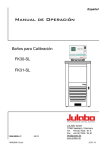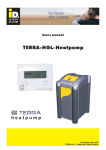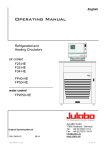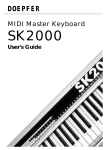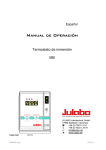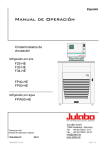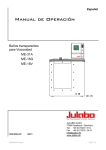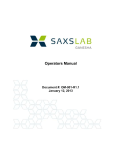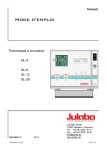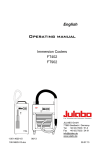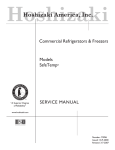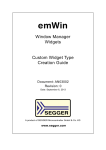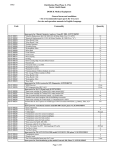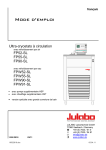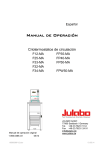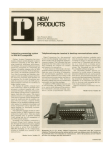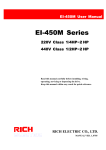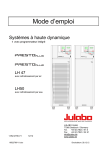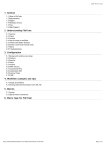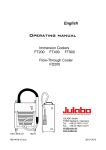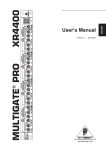Download Operating manual FK30-SL
Transcript
English Operating Manual Calibration Baths FK30-SL FK31-SL 1.951.2829-V2 19512829-V2.doc 06/13 JULABO GmbH 77960 Seelbach / Germany Tel. +49 (0) 7823 / 51-0 Fax +49 (0) 7823 / 24 91 [email protected] www.julabo.de 22.07.13 Congratulations! You have made an excellent choice. JULABO thanks you for the trust you have placed in us. This operating manual has been designed to help you gain an understanding of the operation and possible applications of our circulators. For optimal utilization of all functions, we recommend that you thoroughly study this manual prior to beginning operation. The JULABO Quality Management System Temperature control devices for research and industry are developed, produced, and distributed according to the requirements of ISO 9001 and ISO 14001. Certificate Registration No. 01 100044846 Unpacking and inspecting Unpack the circulator and accessories and inspect them for possible transport damage. Damage should be reported to the responsible carrier, railway, or postal authority, and a damage report should be requested. These instructions must be followed fully for us to guarantee our full support of your claim for protecting against loss from concealed damage. The form required for filing such a claim will be provided by the carrier. Printed in Germany Changes without prior notification reserved Important: keep operation manual for future use 2 SL TABLE OF CONTENTS Operating manual .................................................................................................................. 5 1. Intended use ................................................................................................................... 5 1.1. Description ................................................................................................................. 5 2. Operator responsibility – Safety recommendations ........................................................ 6 2.1. Disposal ..................................................................................................................... 8 2.2. EC Conformity ............................................................................................................ 9 2.3. Warranty conditions ................................................................................................... 9 2.4. Technical specifications ........................................................................................... 10 Operating instructions ......................................................................................................... 12 3. Safety notes for the user .............................................................................................. 12 3.1. Explanation of safety notes ...................................................................................... 12 3.2. Explanation of other notes ....................................................................................... 12 3.3. Safety recommendations ......................................................................................... 13 4. Operating controls and functional elements ................................................................. 15 5. Preparations ................................................................................................................. 19 5.1. Installation ................................................................................................................ 19 5.2. Bath fluids ................................................................................................................ 20 5.3. Filling / draining ........................................................................................................ 21 6. Operating procedures ................................................................................................... 22 6.1. Power connection .................................................................................................... 22 6.2. Switching on / Selecting the language ..................................................................... 22 6.2.1. Switching on the cooling machine ....................................................................... 23 6.3. Start - Stop ............................................................................................................... 23 6.4. Adjusting the temperature chamber ......................................................................... 23 7. Setting of temperatures................................................................................... 24 8. Safety installations, warning functions ............................................................ 24 8.0.1. Early warning system, low level protection .......................................................... 28 Menu functions ............................................................................................... 29 9. 9.1. Start of a program .................................................................................................... 31 9.1.1. Status at the end of a program ............................................................................ 33 9.1.2. Indication after successful start ........................................................................... 33 9.1.3. Editing after Start ................................................................................................. 34 9.1.4. Interrupting a program ......................................................................................... 34 9.1.5. Interruption after a power failure.......................................................................... 35 9.1.6. Termination of a program .................................................................................... 35 9.2. Program administration, creation ............................................................................. 36 9.3. Setting the pump pressure ....................................................................................... 40 9.4. Configuration ............................................................................................................ 41 9.4.1. Remote control via the serial interface ................................................................ 44 9.4.2. Keypad control or setpoint setting via the analog input ....................................... 44 9.4.3. Autostart .............................................................................................................. 45 9.4.4. Off-Mode ............................................................................................................. 45 3 9.4.5. ActVar - actuating variable ................................................................................... 46 9.4.6. Setting of clock and date ...................................................................................... 47 9.4.7. Language ............................................................................................................. 47 9.4.8. Unit ....................................................................................................................... 47 9.4.9. Program type ........................................................................................................ 47 9.4.10. Reset ............................................................................................................... 47 9.4.11. C-Sensor - Precision reference sensor ........................................................... 48 9.5. Control ......................................................................................................................49 9.5.1. Control internal / external .................................................................................... 51 9.5.2. Selftuning ............................................................................................................. 52 9.5.3. Dynamik intern ..................................................................................................... 52 9.5.4. CoSpeed - extern ................................................................................................. 53 9.5.5. Control parameters – internal/external ................................................................. 53 9.6. Serial Interface .......................................................................................................... 55 9.7. ATC Absolute Temperature Calibration, 3-point calibration...................................... 56 9.7.1. ATC Fühler - intern / extern .................................................................................. 59 9.7.2. ATC Status - yes / no ........................................................................................... 59 9.7.3. Type 1 -/ 2 -/ 3 point ............................................................................................ 59 9.7.4. Example: 3-point calibration for internal control .................................................. 60 9.8. Limits ........................................................................................................................62 9.8.1. Limits for internal control and external control ...................................................... 63 9.8.2. Limits for external control ..................................................................................... 64 9.9. Analog inputs/outputs ............................................................................................... 65 9.9.1. Outputs of the connector - REG+E-PROG ........................................................... 69 9.9.2. Input of the connector - REG+E-PROG ............................................................... 70 9.9.3. External Stand-by input ........................................................................................ 72 9.9.4. Alarm-output ......................................................................................................... 73 10. Troubleshooting guide / Error messages....................................................................... 74 11. Electrical connections .................................................................................................... 77 12. Remote control .............................................................................................................. 80 12.1. Setup for remote control ........................................................................................... 80 12.2. Communication with a PC or a superordinated data system .................................... 80 12.3. List of commands ...................................................................................................... 81 12.4. Status messages ...................................................................................................... 85 12.5. Error messages......................................................................................................... 85 13. Installation of electronic module with analog connectors .............................................. 86 14. JULABO Service – Online remote diagnosis ................................................................. 87 15. Cleaning / repairing the unit .......................................................................................... 88 4 SL Operating manual 1. Intended use JULABO circulators have been designed to control the temperature of specific fluids in a bath tank. JULABO circulators are not suitable for direct temperature control of foods, semiluxury foods and tobacco, or pharmaceutical and medical products. Direct temperature control means unprotected contact of the object with the bath medium (bath fluid). 1.1. Description ICC TCF ATC3 The circulators are operated via the splash-proof keypad. The implemented microprocessor technology allows to set and to store different values that can be indicated on the VFD COMFORT-DISPLAY and LCD DIALOG-DISPLAY. Three menu keys facilitate adjusting setpoints, warning and safety functions and menu functions. The integrated programmer allows storing and running temperature and timedependent processes. The control electronics including “ICC - Intelligent Cascade Control“ automatically adapts the heat supplied to the thermal requirements of the bath. The TCF - Temperature Control Features allow the user to have access to all important temperature control parameters. This means: Full control on the control mode and the chance to manually adjust or adapt control to the specific application. Absolute Temperature Calibration (ATC3) provides high temperature stability in the bath. With the 3-point calibration an offset is adjusted at three temperatures to ensure an accurate temperature pattern at the selected spot in the bath over the full temperature range. Electrical connections: The serial interface, switchable from RS232 to RS485, allows modern process technology without additional interface. Connection for Pt100 external sensor for external temperature measurement and control. Alarm output for external alarm message or control of JULABO refrigerating baths or solenoid valve (cooling water). The electronic module (option) provides 3 further analog connections (alarm input, standby input, recorder output, programmer input). The excess temperature protection conforming to IEC 61010-2-010 is a safety installation independent from the control circuit. This protection can be indicated and set on the LCD DIALOG-DISPLAY. RS232 RS485 Pt100 SMART PUMP The early warning system for low level signals that bath fluid needs to be refilled before the low level protection conforming to IEC 61010-2-010 causes a complete shut-down of the main functional elements. Intelligent pump system: The pump capacity (electronically adjustable via the motor speed) enables to adapt to varying conditions for internal and external temperature applications. 5 Operator responsibility – Safety recommendations 2. Operator responsibility – Safety recommendations The products of JULABO ensure safe operation when installed, operated, and maintained according to common safety regulations. This section explains the potential dangers that may arise when operating the circulator and also specifies the most important safety precautions to preclude these dangers as far as possible. The operator is responsible for the qualification of the personnel operating the units. The personnel operating the units should be regularly instructed about the dangers involved with their job activities as well as measures to avert these dangers. Make sure all persons tasked with operating, installing, and maintaining the unit have read and understand the safety information and operating instructions. When using hazardous materials or materials that could become hazardous, the circulator may be operated only by persons who are absolutely familiar with these materials and the circulator. These persons must be fully aware of possible risks. If you have any questions concerning the operation of your unit or the information in this manual, please contact us! Contact JULABO GmbH Eisenbahnstraße 45 77960 Seelbach / Germany Tel. +49 (0) 7823 / 51-0 Fax +49 (0) 7823 / 24 91 [email protected] www.julabo.de Safety instructions for the operator: You have received a product designed for industrial use. Nevertheless, avoid strikes to the housing, vibrations, damage to the operating-element panel (keypad, display), and contamination. Make sure the product is checked for proper condition regularly (depending on the conditions of use). Regularly check (at least every 2 years) the proper condition of the mandatory, warning, prohibition and safety labels. Make sure that the mains power supply has low impedance to avoid any negative effects on instruments being operated on the same mains. This unit is designed for operation in a controlled electromagnetic environment. This means that transmitting devices (e.g., cellular phones) should not be used in the immediate vicinity. Magnetic radiation may affect other devices with components sensitive to magnetic fields (e.g., monitors). We recommend maintaining a minimum distance of 1 m. Permissible ambient temperature: max. 40 °C, min. 5 °C. Permissible relative humidity: 50% (40 °C). Do not store the unit in an aggressive atmosphere. Protect the unit from contamination. Do not expose the unit to sunlight. Appropriate operation Only qualified personnel is authorized to perform configuration, installation, maintenance and repairs of the circulator. Routine operation can also be carried out by untrained personnel who should however be instructed by trained personnel. 6 SL Use: The bath can be filled with flammable materials. Fire hazard! There might be chemical dangers depending on the bath medium used. Observe all warnings for the used materials (bath fluids) and the respective instructions (safety data sheets). Insufficient ventilation may result in the formation of explosive mixtures. Only use the unit in well ventilated areas. Only use recommended materials (bath fluids). Only use non-acid and non corroding materials. When using hazardous materials or materials that could become hazardous, the operator must affix the enclosed safety labels to the front of the unit so they are highly visible: When using hazardous materials or materials that could become hazardous, the operator must affix the enclosed safety labels (1 + 2) to the front of the unit so they are highly visible: 1 Warning label W00: Colors: yellow, black Danger area. Attention! Observe instructions. (operating manual, safety data sheet) 2 Mandatory label M018: Colors: blue, white Carefully read the user information prior to beginning operation. Scope: EU or 2 Semi S1-0701 Table A1-2 #9 Carefully read the user information prior to beginning operation. Scope: USA, NAFTA Particular care and attention is necessary because of the wide operating range. There are thermal dangers: Burn, scald, hot steam, hot parts and surfaces that can be touched. Warning label W26: Colors: yellow, black Hot surface warning. (The label is put on by JULABO) Observe the instructions in the manuals for instruments of a different make that you connect to the circulator, particularly the respective safety recommendations. Also observe the pin assignment of plugs and technical specifications of the products. 7 Operator responsibility – Safety recommendations 2.1. Disposal The circulator contains a back-up battery that supplies voltage to memory chips when the unit is switched off. Do not dispose of the battery with household waste! Depending on battery regulations in your country, you might be obliged to give back used or defect batteries to gathering places. The product may be used with oil as bath fluid. These oils fully or partially consist of mineral oil or synthetic oil. For disposal, observe the instructions in the safety data sheets. This unit contains refrigerants, which at this time are not considered harmful to the ozone layer. However, over the long operating period of the unit, disposal rules may change. Therefore, only qualified personnel should handle the disposal. Valid in EU countries See the current official journal of the European Union – WEEE directive. Directive of the European Parliament and of the Council on waste electrical and electronic equipment (WEEE). This directive requires electrical and electronic equipment marked with a crossedout trash can to be disposed of separately in an environmentally friendly manner. Contact an authorized waste management company in your country. Disposal with household waste (unsorted waste) or similar collections of municipal waste is not permitted! 8 SL 2.2. EC Conformity The products described in the operating instructions conform to the requirements of the following European guidelines: Directive of the European Parliament and of the Council on the approximation of the laws of the Member States relating to machinery. EMC guideline with respect to legal harmonization of the member countries concerning electromagnetic compatibility. JULABO GmbH Eisenbahnstr. 45 77960 Seelbach / Germany 2.3. Warranty conditions JULABO GmbH warrants its products against defects in material or in workmanship, when used under appropriate conditions and in accordance with appropriate operating instructions for a period of ONE YEAR. Extension of the warranty period – free of charge With the ‘1PLUS warranty’ the user receives a free of charge extension to the warranty of up to 24 months, limited to a maximum of 10 000 working hours. To apply for this extended warranty the user must register the unit on the JULABO web site www.julabo.de, indicating the serial no. The extended warranty will apply from the date of JULABO GmbH’s original invoice. JULABO GmbH reserves the right to decide the validity of any warranty claim. In case of faults arising either due to faulty materials or workmanship, parts will be repaired or replaced free of charge, or a new replacement unit will be supplied. Any other compensation claims are excluded from this guarantee. 9 Operator responsibility – Safety recommendations 2.4. Technical specifications Calibration Baths Working temperature range Temperature stability (1 Temperature uniformity Cooling capacity Medium: ethanol Refrigerant Overall dimensions (WxDxH) Bath opening (WxL) Bath depth Filling volume Weight Mains power connection 230 V/50 Hz Current draw (at 230 V) Current draw (at 230 V) <GB> Mains power connection 115 V/60 Hz Current draw (at 115 V) (1 °C °C °C °C kW cm cm cm Liter kg V/ Hz A A A V/ Hz A A FK30-SL -30 ... 200 ±0.005 <±0.01 +20 0 -20 0.46 0.34 0.15 R134a 32x45x79 12 17 14 48 207-253 / 50 14 10 (Circulator) 4 (Cooling machine) 103-127 / 60 10 (Circulator) 6 (Cooling machine) FK31-SL -30 ... 200 ±0.005 <±0.01 +20 0 -20 0.46 0.34 0.15 R134a 32x45x91 12 31 24 51 207-253 / 50 14 10 (Circulator) 4 (Cooling machine) 103-127 / 60 10 (Circulator) 6 (Cooling machine) ±0.02 °C@+200 °C Circulator (SL-C) Temperature selection via keypad remote control via PC Temperature indication Resolution ATC3 Temperature control Heater wattage (at 230 V) Heater wattage (at 115 V) kW kW SL digital indication on LCD DIALOG-DISPLAY (°C/°F) indication on monitor VFD COMFORT-DISPLAY (°C/°F) 0.01 ±3 / ±9 ICC - Intelligent Cascade Control 2.0 1.0 Electronically adj. pump capacity Flow rate at 0 bar Max. pressure at 0 liters Max. suction at 0 liters Ambient temperature stages l/min bar bar °C 1 ... 4 22 ... 26 0.7 0.4 5 ... 40 Mains power connection 230 V/50-60 Hz Current draw (at 208 V / 230 V) Mains power connection 115 V/50-60 Hz Current draw (at 100 V / 115 V) V/ Hz A V/ Hz A 190 ... 253 / 50-60 12 / 13 90 ... 127 / 50-60 9/10 INT / EXT °C °C All measurements have been carried out at: rated voltage and frequency ambient temperature: 20 °C Technical changes without prior notification reserved. 10 SL Electrical connections: External alarm device 24-0 V DC / max. 25 mA Computer interface RS232 or RS485 External Pt100 sensor Optional for HL, SL (Order No. 8900100 Electronic module with analog connections) Programmer input -100 °C to 400 °C = 0 - 10 V or 0 - 20 mA or 4 - 20 mA Input for the signal of a flow meter or external manipulated variable Temperature recorder outputs 0 - 10 V (0 V = -100 °C, 10 V = 400 °C) 0 - 20 mA (0 mA = -100 °C, 20 mA = 400 °C) 4 - 20 mA (4 mA = -100 °C, 20 mA = 400 °C) Standby input for external emergency switch-off Alarm output for external alarm signal Safety installations according to IEC 61010-2-010: Excess temperature protection adjustable from 0 °C ... 320 °C Low liquid level protection float switch Classification according to DIN 12876-1 class III Supplementary safety installations Early warning system for low level High temperature warning function Low temperature warning function Supervision of working sensor Reciprocal sensor monitoring between working and safety sensors Alarm message Warning message float switch optical + audible (in intervals) optical + audible (in intervals) plausibility control difference >35 K optical + audible (permanent) optical + audible (in intervals) Environmental conditions according to IEC 61 010-1: Use indoors only. Altitude up to 2000 m - normal zero. Ambient temperature: see Technical specifications Humidity: Max. relative humidity 80% for temperatures up to +31 °C, linear decrease down to 50% relative humidity at a temperature of +40 °C Max. mains voltage fluctuations of ±10% are permissible. Protection class according to IEC 60 529 IP21 The unit corresponds to Class I Overvoltage category II Pollution degree 2 Caution: The unit is not suitable for use in explosive environment EMC requirements according to EN 61326-1 This unit is an ISM device classified in Group 1 (using high frequency for internal purposes), Class A (industrial and commercial range). 11 Operating instructions Operating instructions 3. 3.1. Safety notes for the user Explanation of safety notes In addition to the safety warnings listed, warnings are posted throughout the operating manual. These warnings are designated by an exclamation mark inside an equilateral triangle. “Warning of a dangerous situation (Attention! Please follow the documentation).” The danger is classified using a signal word. Read and follow these important instructions for averting dangers. Warning: Describes a possibly highly dangerous situation. If these instructions are not followed, serious injury and danger to life could result. Caution: Describes a possibly dangerous situation. If this is not avoided, slight or minor injuries could result. A warning of possible property damage may also be contained in the text. Notice: Describes a possibly harmful situation. If this is not avoided, the product or anything in its surroundings can be damaged. 3.2. Explanation of other notes Note! Draws attention to something special. Important! Indicates usage tips and other useful information. This icon is used in the operating instructions to indicate flashing values or parameters which have to be set or confirmed. 12 SL 3.3. Safety recommendations Follow the safety instructions to avoid personal injury and property damage. Also, the valid safety instructions for workplaces must be followed. Only connect the unit to a power socket with an earthing contact (PE – protective earth)! The power supply plug serves as a safe disconnecting device from the line and must always be easily accessible. Place the unit on an even surface on a base made of nonflammable material. Do not stay in the area below the unit. Make sure you read and understand all instructions and safety precautions listed in this manual before installing or operating your unit. Set the excess temperature safety installation at least 25 °C below the fire point of the bath fluid. Observe the limited working temperature range when using plastic bath tanks. Never operate the unit without bath fluid in the bath. Pay attention to the thermal expansion of bath oil during heating to avoid overflowing of the fluid. Prevent water from entering the hot bath oil. Do not drain the bath fluid while it is hot! Check the temperature of the bath fluid prior to draining (e.g., by switching the unit on for a short moment). Use suitable connecting tubing. Avoid sharp bends in the tubing, and maintain a sufficient distance from surrounding walls. Make sure that the tubing is securely attached. Regularly check the tubing for material defects (e.g., for cracks). Never operate damaged or leaking units. Always turn off the unit and disconnect the mains cable from the power source before performing any service or maintenance procedures, or before moving the unit. Always turn off the unit and disconnect the mains cable from the power source before cleaning the unit. Always empty the bath before moving the unit. Transport the unit with care. Sudden jolts or drops may cause damage in the interior of the unit. Observe all warning labels. Never remove warning labels. Never operate units with damaged mains power cables. Repairs are to be carried out only by qualified service personnel. Some parts of the bath tank and the pump connections may become extremely hot during continuous operation. Therefore, exercise particular caution when touching these parts. 13 Safety notes for the user Caution: The temperature controlling i.e. of fluids in a reactor constitutes normal circulator practice. We do not know which substances are contained within these vessels. Many substances are: inflammable, easily ignited or explosive hazardous to health environmentally unsafe i.e.: dangerous The user alone is responsible for the handling of these substances! The following questions shall help to recognize possible dangers and to reduce the risks to a minimum. Are all tubes and electrical cables connected and installed? Note: sharp edges, hot surfaces in operation, moving machine parts, etc. Do dangerous steams or gases arise when heating? Is an exhaust needed when working? What to do when a dangerous substance was spilled on or in the unit? Before starting to work, obtain information concerning the substance and determine the method of decontamination. 14 Notice: Check the safety installations at least twice a year! Excess temperature protection according to IEC 61010-2-010. With a screwdriver turn back the adjustable excess temperature protection until the shut-down point (actual temperature). Low level protection according to IEC 61010-2-010. To check the function of the float, it can be manually lowered with a screwdriver for example. SL 4. Operating controls and functional elements Front view 1a 1b 2 Rear view Mains power switch, illuminated for circulator Mains power switch, illuminated for cooling machine VFD COMFORT-DISPLAY Header: Control indicators Line 1: Actual value internal or external The display is depending on the selected control mode in the menu > Control < (internal or external). or Actual value of the precision reference sensor „C“ xxx.xx Line 2: Working temp. setpoint, constantly S xxx.xx Line 3: Actual value (E = external or I = internal or C= reference sensor) Alternating with the display in line 1 Use the keys to indicate further values in line 3 PI Capacity in % - with manipulated variable set to >control<* 15 Operating controls and functional elements PS H U F Capacity in % - with manipulated variable set to >serial<* or >eprog<* Heater capacity in Watts Mains voltage Volts Flow rate in liters/minute (providing EPROG input set to >Flow rate<) *refer to >MENU / CONFIGIGURATIO> page 31 2.1 Control indicators in the header: Heating / Cooling / Alarm / Remote control 2.2 Control indicators in the header: Temperature indication Internal or External actual value Temperature indication in °C or °F 2.3 Display for the adjusted pump pressure stage in the -OFF- mode. Display for the effective pump pressure stage (rotation speed) after start. button, in the menu >PUMP<. Four stages, adjustable via the 3 LCD DIALOG-DISPLAY Line 1: Setpoint and origin of setpoint programming (Key / RS232 or RS485 / ext. Pt100 / EProg) Line 2: Actual value - internal or external, identical to line 1 of the VFD-COMFORT-DISPLAY Line 3: Heating capacity in %. Line 4: Control type: internal / external Navigation aid in MENU - Window / : Keys Selection of menu items / parameters - Setting in line 3: Actual value / parameter Orientation aid in MENU - Window Line 1 - name with allocation to key Safety values T – Setpoint 1 Main menu Level 1 2 Submenu Level 2 Example: CONFIGURATION 3 Submenu Level 3 16 SL 4 Keypad 1 Navigation keys 1. Key: >OK< Start / Stop (pump / heater ) 2. >OK< in the menu Menu item / select submenu for setting Save set value Save selected parameter A beep signals the end of setting 4.1 After the actions Start, Stop and change from VFD Display to standard is locked for a short time. display the key The above graph “front side” shows an example for standard display. 4.2 1. Key: >Return< Stop (pump / heater) Special display on VFD Display leave line 3. 2. >Return< in the menu one menu level down Correction function for parameters or values (prior to OK) immediately back to standard display - icon for „keep key pressed down“. 1. Key: >Up / Down <temperature – increase/decrease setpoint Push key quickly for single steps, Keep key pressed for fast change. 2. >Up/Down< in the menu selection of menu items / parameters 4.3 Menu keys 4.4 Key: start the menu > warning and safety values< 4.5 Key: start the menu >temperature setpoints< 4.6 Key: display of MENU structure 5 Keypad 2 .. Numeric keypad: numerals 0 to 9 minus / decimal point Backspace key on LCD DIALOG-DISPLAY. 6 Adjustable excess temperature protection according to IEC 61010-2-010 17 Operating controls and functional elements Rear view 7 ext Pt100 8 Socket for external measurement and control sensor or external setpoint programming Interface RS232 / RS485: remote control via personal computer SERIAL 9 or Socket for a precision reference sensor Socket: control cable of JULABO refrigerated circulator or output for alarm messages Option: Electronic module Order No. 8 900 100 The circulator automatically recognizes the connected electronic module. 10 Alarm output (for external alarm signal) ALARM 11 Standby input (for external emergency switch-off) STAND-BY 12 Programmer input and temperature recorder output REG+E-PROG 16a 16b Mains fuses for Circulator: T16A 17a 17b Mains power cable with plug for circulator 18 Built-in mains outlet for connection of circulator (230 V / 16 A) 19 Drain screw with drain connection 20 Venting grid, removable 18 Mains fuses for cooling machine: T 10,0 A Mains power cable with plug cooling machine SL 5. 5.1. Preparations Installation Place the unit on an even surface on a pad made of non-flammable material. Cooling machine, pump motor and electronics produce intrinsic heat that is dissipated via the venting openings! Never cover these openings! Keep at least 20 cm of open space on the front and rear venting grids. The place of installation should be large enough and provide sufficient air ventilation to ensure the room does not warm up excessively because of the heat the instrument rejects to the environment. (Max. permissible ambient temperature: 40 °C). For a fault (leakage) in the refrigeration system, the standard EN 378 prescribes a certain room space to be available for each kg of refrigerant. The refrigerant quantity is specified on the type plate. > > For 0.25 kg of refrigerant R134a, a room space of 1 m3 is required. Do not set up the unit in the immediate vicinity of heat sources and do not expose to sun light Before operating the unit after transport, wait about one hour after setting it up. This will allow any oil that has accumulated laterally during transport to flow back down thus ensuring maximum cooling performance of the compressor. The bath cover (1) is mounted on the bath tank with 4 captive screws (2). Required tool: SW3 hexagonal socket wrench with ball-shaped head The circulating pump transports the bath fluid to the temperature chamber (4) at the bottom (3). The overflow on top of the chamber ensures a constant fluid level during operation. The bath cover (5) provides 6 measuring places (6) that can be fitted with different Viton® sleeves.. Order-No.: 8 930 602 8 930 603 8 930 604 8 930 605 8 930 605 8 930 608 Viton® sleeves 2 mm inner dia. 3 mm inner dia. 4 mm inner dia. 5 mm inner dia. 6 mm inner dia. 8 mm inner dia. Take off the complete insert for cleaning. The gasket below the bath cover should be replaced in this case. Part No.: 7.901.1088 Gasket for bath cover FK30, FK31 19 Preparations 5.2. Bath fluids Caution: Carefully read the safety data sheet of the bath fluid used, particularly with regard to the fire point! If a bath fluid with a fire point of 65 °C is used, only supervised operation is possible. Water: The quality of water depends on local conditions. Due to the high concentration of lime, hard water is not suitable for temperature control because it leads to calcification in the bath. Ferrous water can cause corrosion - even on stainless steel. Chloric water can cause pitting corrosion. Distilled and deionized water is unsuitable. Their special properties cause corrosion in the bath, even in stainless steel. Recommended bath fluids: Bath fluid Temperature range soft/decalcified water mixture water/glycol, mixture 1:1 5 °C to 80 °C -20°C to 50°C JULABO bath fluids JULABO Description Order Number Temperature range Flash point Fire point Color JULABO Description Order Number Temperature range Flash point Fire point Color 10 liters 5 liters °C °C °C 10 liters 5 liters °C °C °C Thermal G 8 940 124 8 940 125 -30 ... 80 --light yellow Thermal H10 8 940 114 8 940 115 -20 ... 180 190 216 clear Thermal HY 8 940 104 8 940 105 -80 ... 55 78 80 clear Thermal H5 8 940 106 8 940 107 -50 ...105 124 142 clear Thermal H20S 8 940 108 8 940 109 0 ... 220 230 274 light brown See website for list of recommended bath fluids. ATTENTION: The maximum permissible viscosity is 70 mm2 /s. Caution: Fire or other dangers when using bath fluids that are not recommended: Use only non-acidic and non-corroding bath fluids. JULABO assumes no liability for damage caused by the selection of an unsuitable bath liquid. Unsuitable bath fluids are fluids which, e.g., 20 SL are highly viscous (much higher than recommended at the respective working temperature) have a low viscosity and have creep characteristics have corrosive characteristics or tend to crack. No liability for use of other bath fluids! 5.3. Filling / draining Notice: Pay attention to the thermal expansion of bath oil during heating to avoid overflowing of the liquid. Do not drain the bath fluid while it is hot! Recommendation: Temperature range 5 °C to 40 °C Check the temperature of the bath fluid prior to draining (by switching the unit on for a short moment, for example). Store and dispose the used bath fluid according to the laws for environmental protection. Filling Take care that no liquid enters the interior of the circulator. The recommended filling level is marked with an angle plate (M) inside the bath. When the filling level does not exceed the marker (M) and providing a suitable bath fluid is used for the specified working temperature range of the unit, neither low liquid level alarm should be triggered nor overflowing of the bath fluid should be caused. Draining: 19 Turn off the unit and disconnect the mains cable from the power source. Hold the venting grid, pull out and remove. Slide a short piece of tube onto the drain connection and hold it into a container. Loosen the drain screw a few turns and drain the unit completely. Tighten the drain tap. 21 Operating procedures 6. 6.1. Operating procedures Power connection Caution: Only connect the unit to a power socket with earthing contact (PE – protective earth)! The power supply plug serves as safe disconnecting device from the line and must be always easily accessible. Never operate equipment with damaged mains power cables. Regularly check the mains power cables for material defects (e.g. for cracks). We disclaim all liability for damage caused by incorrect line voltages! Check to make sure that the line voltage matches the supply voltage specified on the identification plate. Connect the circulator with mains power cable (17a) to the mains outlet (18). Connect the control cable (9) to the sockets (9a, 9b). 6.2. Connect the refrigerated circulator with mains power cable (17b) to the mains socket. Switching on / Selecting the language Switching on: Turn on the mains power switch (1a). The unit performs a self-test. Then the software version (example: V 1.12-S008C) appears. The display „OFF“ or „R OFF“ indicates the unit is ready to operate. The circulator enters the operating mode activated before switching the circulator off: keypad control mode (manual operation) or remote control mode (operation via personal computer). Selecting the language: There are two options for the language of the LCD DIALOG-DISPLAY: German or English. Select the desired language in the menu >Configuration< under the submenu >Language/Sprache<. Press the respective keys in the following order: 3x up to menu Configuration 6x up to submenu >Language/Sprache< deutsch / english 22 SL 6.2.1. Switching on the cooling machine Switch on the cooling machine using the switch (1b) . Control of the cooling machine: With the mains switch (1b) turned on, the circulator automatically switches the cooling machine off and on. To save energy, turn off the cooling machine with the mains switch (1b) whenever cooling is not required. 6.3. Start - Stop Start: Press key. The actual bath temperature is displayed on the VFD COMFORTDISPLAY. The circulating pump starts with a slight delay. Stop: Press or Keep key. key pressed. The VFD COMFORT-DISPLAY indicates the message "OFF". 6.4. Adjusting the temperature chamber Adjusting the temperature chamber after set up: If bath fluid overflow in the temperature chamber is not equal in every direction, an adjustment can be made with the 3 screws that are accessible from above. Required tool: SW3 hexagonal socket wrench with ball-shaped head 23 Setting of temperatures 7. Setting of temperatures Press the key to call up the menu for temperature selection. 3 different working temperatures can be adjusted. Their values are freely selectable within the operating temperature range. The temperatures can be set in start or stop mode. menu Setting of working temperature in the Factory settings: 1. Press the key . The value flashes 2. Select SETPOINT 1 or 2 or 3 using the key 3. Confirm by pressing the or . key. The circulator uses the new working temperature value for temperature control. Example: Adjustment/modification of the pre-setting of "SETPOINT 3" If the active Setpoint is changed, the new value is immediately used for the control of the working temperature. The heater control indicator flashes. Setpoint3: Change the value from 70.00°C to 80.00°C. See standard display line 1 Use the numeric keypad to enter Then press enter and . to store the value. Notice: Refer to SETPOINT MAX / MIN in chapter „LIMITS“ 8. Safety installations, warning functions Check the safety installations at least twice a year! Refer to page 14. Settings for the excess temperature protection > SafeTemp< and for the warning functions > OverTemp< and > SubTemp< are made in a menu . which is called up by pressing the key Menu item > Type< allows choosing between a warning and an alarm cut-off for the menu items > OverTemp< and > SubTemp<. 24 SL Warning: The excess temperature protection must be set at least 25 °C below the fire point of the bath fluid used! In case of wrong setting there is a fire hazard! We disclaim all liability for damage caused by wrong settings! SafeTemp: Setting range: 20 °C ... 320 °C Rough setting can be effected by using the temperature scale. Settings: SafeTemp: Type: Press the key and by pressing the key or and confirm the by pressing the key . menu item select the For setting proceed as follows. Set the new cut-out value within 30 seconds with a screw driver. Exact display and setting on LCD display Recommendation: Set over temperature-protective setting >SafeTemp< 5 °C to 10 °C above the set point of the working temperature. Switch-over from warning to shutdown function Change the parameter by pressing the key . pressing the key or and confirm by if the parameter is to be retained. pressing the key Possible parameters: warning or alarm OverTemp : SubTemp: Set value on numeric keypad and confirm by pressing Example: 83.00 °C Press the keys Sensor: and and confirm by pressing Indicated is the temperature value of the safety sensor. SafeTemperature: Setting range: 20 °C ... 320 °C Indicated is the cut-out value set with a screwdriver on the excess temperature protection device. This safety installation is independent of the control circuit. When the temperature of the bath fluid has reached the safety temperature, a 25 Safety installations, warning functions complete shutdown of the heater and pump is effected. The alarm is indicated by optical and audible signals (continuous tone). The following error message appears on the VFD COMFORT-DISPLAY: for help on the LCD Press Depending on the setting of >ControlType - internal or external< the actual temperature values for both sensors are shown/indicated on both displays. Examples: I 94.06 and Ext. : xx.xx°C Type: >Warning< or >Alarm< For the two menu items >OverTemp< and >SubTemp< choose between a warning message being signaled or a complete shutdown of the main functional elements such as heater and circulating pump being effected. OverTemperature: SubTemperature: If for a sensitive temperature application task adherence to a working temperature value >Setpoint< is to be supervised, then set high and low temperature warning values. In the example below, the >Setpoint< of 85 °C is surrounded by the values >OverTemp< 87 °C and >SubTemp< 83 °C. The electronics immediately registers when the actual temperature attains a temperature out of the limits and it follows a reaction according to what is set in the menu item >-Type<. Setpoint3 85.0°C OverTemp 87.0°C SubTemp 83.0°C The warning functions are only triggered when the actual bath temperature, after start from the „OFF“ or „rOFF“ mode, lies within the set limits for 3 seconds. 26 SL Setting >WARNING< A mere warning function with optical and audible warning signal (interval tone) A message appears on the VFD COMFORT-DISPLAY: or OverTemp SubTemp The LCD –DISPLAY shows the message: Setting >ALARM< Temperature limit with shutdown of heater and circulating pump. An audible alarm sounds (continuous tone) and a message appears on the VFD COMFORT-DISPLAY: or OverTemp SubTemp The LCD -DISPLAY shows the message Press for help on the LCD 27 Safety installations, warning functions 8.0.1. Early warning system, low level protection This low level protection is independent of the control circuit and is divided into two sections: DBGM: 20306059.8 1. Switch in stage 1 recognizes a critical fluid level . An audible warning (interval tone) sounds and a message appears on the VFD COMFORT-DISPLAY. Refill bath fluid! 2. Switch in stage 2 recognizes a low fluid level . If stage 2 of the low level protection device (according to IEC 61010-2-010) is triggered, a complete shutdown of the heater and circulating pump is effected. A continuous alarm tone sounds and a message >ALARM< >CODE 01< appears on the VFD COMFORT-DISPLAY. Press for help on the LCD Turn off the unit with the mains switch, refill bath fluid and turn the unit on again! 3. Float 4. Circulating pump 5. Heater Warning: For refill always use the same bath fluid type that is already in the bath. Bath oils must not contain any water contaminants and should be pre-heated to the actual bath temperature! Explosion hazard at higher temperatures! 28 SL 9. Menu functions The term „menu functions“ refers to adjustments such as Menu level 1 Start program Page 31 This menu will start a previously set program. Administration and creation of programs Page 36 Electronically adjustable pump capacity Page 40 The capacity of the circulating pump is set by adjusting the motor speed. Configuration of the unit Page 41 Remote – on / off (remote control via RS232) Setpoint ext - Switch over external setpoint setting Autostart – AUTOSTART on / off Off-Mode – Pump on / off ACTVAR - Switch over input variable Time / Date – setting time and date Language – english / deutsch Unit – Temperature values can be displayed in °C or °F. Program Type – Time or Gradient (grad) Reset – factory settings C-Sensor (Precision Pt100 reference sensor) Control characteristics and parameters ControlType - Control internal or external Selftuning Dynamic - internal CoSpeed – external Control parameters - XP-, TN-, TV- internal Control parameters - XP-, TN-, TV- XPU-, external Page 49 29 Menu functions Menu level 1 Adjustable interface parameters BAUDRATE, PARITY, HANDSHAKE Page 55 ATC - Absolute Temperature Calibration, Sensor calibration internal sensor, Sensor calibration external sensor 3-point calibration Page 56 Limitations of temperature and capacity Page 63 Setpoint Max / Min - Maximum and minimum setpoint Heating Max – Set maximum heating Cooling Max – Set maximum cooling Internal Max / Min – Limitation of the temperature range Upper band / Lower band – Band limit Analog inputs/outputs Recorder output – CHANNEL 1, 2, 3 EPROG – External programmer input Ext-StBy - Stand-By input ALARM - output 30 Page 65 SL 9.1. Start of a program The start menu of the integrated programmer allows one of six previously stored temperature programs to be called up and started. The profiles are started manually or via the integrated timer. Requirements: 1. Create a program. (refer to next chapter) 2. Return to the Start-MENU and confirm the desired setting of each MENU item with the key 3. Set a start time (>TIME< >DATE< >YEAR<) if the program is to be started by the internal timer. >Program Number< Select the program that should be started. 0 ... 5 Level 2 > at Step< Select the Step at which the program should be started. 0 … 59 > Runs < Select the number of program repetitions. 1 ... 99 > Program End< Status at program end . StdBy, PSetp, Setp 1, Setp 2, Setp 3 > RUN < Start time (now / time) key if a parameter is to be retained. (prior to OK) Press the Parameter /Value Set a parameter using the numeric keypad and confirm by pressing Possible parameters: 0 …5 . Set a parameter using the numeric keypad and confirm by pressing Possible parameters: 0 … 59 Set a parameter using the numeric keypad and confirm by pressing Possible parameters: 1 … 99 . . Set desired parameters with and . Possible parameters: StdBy , PSetp, Setp 1, Setp 2 , Setp 3 31 Menu functions Level 2 Parameter /Value or Set desired parameters with and . Confirm >now< with the key and the program will start immediately or start at the set time under parameter (time ). Set time in the example below: 09. August 2009, 11:15 hrs Submenu TIMER If the parameter time is selected, a further submenu opens for setting the start time. Set the time for the start of the program in the submenu >3 TIMER<. Set starting time using the numeric keypad and confirm by pressing Example: (hh:mm) . + Set day and month using the numeric keypad and confirm by pressing Example: (TT/MM) . + Set year using the numeric keypad and . confirm by pressing Example: (JJJJ) + Confirm >Starten/Start?< by pressing and the program starts at the set time. Display of waiting time until start: The unit switches to waiting mode and a flashing line “wait” appears on the LCD DIALOG-DISPLAY. The start time and current time are permanently indicated on the display. It might be necessary to check the correct setting of the internal real time clock (see MENU configuration) 32 SL 9.1.1. Status at the end of a program Program end StdBy , PSetp, Setp 1, Setp 2 , Setp 3 This parameter is used to determine if the unit switches to the -OFFcondition at the end of a profile or if temperature control is continued, and the working temperature setpoint that is to be used if temperature control is continued. StdBy – If the end of the profile is reached, the circulator switches to the -OFF- condition. The VFD display indicates the working temperature setpoint that was displayed in line 2 before the program was started (example: S 25.00 °C ). PSetp –(Setpoint of the ProGrammer) At the end of the program, the setpoint of the last program step is written to the position of setpoint 3 (example: 80.00 °C) and indicated in line 1 of the LCD display. The circulator operates and controls to this temperature until the key is pressed or a new profile is started. Setp 1, Setp 2, Setp 3 – (“Setp” short for Setpoint) Before starting the programmer, a temperature value is set for one of menu. the three setpoints in the (example: setpoint 2 58.00 °C) The circulator operates and controls to this temperature at the end of is pressed or a new program is started. the profile until the key 9.1.2. Indication after successful start The started programmer displays the currently calculated setpoint in line 1. The value changes until the final temperature of the section is reached (temperature ramp). 1st line: Setpoint of the programmer 2nd line: Actual temperature value for internal control = IntAct: xxx.xx for external control = ExtAct: xxx.xx 3rd line: Selected profile and the current section (step). 4th line: With the keys, the following information can be displayed in line 4. Examples: Remaining time of the current section (standard display) Total remaining time: profile x number of repetitions (All: Days/hours:minutes:seconds) Particularities : 1. If a total time of more than 999 days is calculated, only the hours are displayed by the unit. (All: hours:minutes:seconds) 2. If the time period of a section is edited after the start, then the remaining total time can no longer be displayed. 33 Menu functions 9.1.3. Editing after Start The programmer allows a running program to be edited. Initiation and exit of the editing function: After the start enter the submenu „3 EDITOR“.by pressing the key See chapter „program administration, creation“ page 36 Exit the editing modus anytime by pressing the key . Particularity for changes in a section that is currently in process. If the target temperature is changed, the slope of the ramp is automatically calculated based on the remaining time of the section. If the time period is changed, the slope of the ramp is automatically calculated based on the new total time of the section. The “remaining total time” (profile x number of repetitions) as described on page 33 can no longer be displayed. 9.1.4. Interrupting a program Press the key to interrupt or continue a profile. The setpoint and time period set for the corresponding section are thus stopped at the values presently achieved. The instrument is put on hold and the message “pause” flashes on the LCD DIALOG DISPLAY. A program can be interrupted or restarted by an external shut-off. AK 2 1 3 STAND-BY Important: For this, in the >Inputs/Outputs< menu, the menu item >Ext. StBy< must be set to >active< and in the >Configuration< menu, >Autostart< needs to be set Setpoint control and timer are interrupted by breaking the contact “AK”. The instrument is put on hold and the message “Stand-By” flashes on the LCD DIALOG-DISPLAY. Notice: This is not an actual emergency switch-off. Warning: Following a power interruption, it would be possible in this condition for the instrument to restart automatically. The safety and warning functions of the instrument should always be used to their fullest capacity. Refer to Warning page 45. 34 SL 9.1.5. Interruption after a power failure It is possible to operate the programmer safely in case of a power failure. Important: For this, >Autostart< needs to be set in the >Configuration< menu. If the AUTOSTART function is activated, the programmer starts again at a point approx. 20 seconds before the interruption took place. However, an uncontrolled change of the bath temperature has occurred. Power failure when the instrument is on hold if start is effected via the built-in timer: If the starting time is not yet reached, the programmer is put on hold again. If the starting time is exceeded, the programmer starts immediately. 9.1.6. Termination of a program A program can be terminated by pressing . The programmer switches back to the Start menu. Further procedures are defined in the MENU >START PROGRAM<, menu item >Program End <. Example: >Program End - StdBy< The VFD COMFORT-DISPLAY displays “OFF”. Interruption after a power failure In case of a power failure, the reaction of the circulator is the same as when switched off and on again with the mains switch. The VFD COMFORT-DISPLAY displays “OFF”. 35 Menu functions 9.2. Program administration, creation The integrated programmer permits fast and easy programming of setpoint temperature sequences. This temperature sequence is called program. A program is composed of individual sections (Step). The sections are defined by duration (t) or Gradient (°/t) and target temperature. The target temperature is the setpoint (SP), which is achieved at the end of a section. The programmer calculates the temperature ramp from the difference in time and temperature. Create programs A flashing segment indicates that a number needs to be entered. Under the submenu “Edit”, enter a program number. Six programs may be stored (numbers 0 to 5). When the program is running, only sections with complete information for the target temperature and time period are considered. It makes sense to skip section numbers in the profile in order to use them later for corrections to the profile. Important: If a time of 00:00 is set for a profile, the profile is continued with the next section only after the setpoint temperature (±0.2 °C) is reached. Example: Step Setpoint Time 36 (Nr.) 1 3 5 6 9 11 14 (°C) 50 50 100 100 80 80 20 (h:m) 00:08 00.02 00:10 01:05 00:10 00:05 00:30 SL Editing PrgNr: Set the program you wish to create. 0 ... 5 SP: Setpoint TI : GRD: Time [hh:mm] or Gradient [°/t] = [°/min] Change type of program in MENU >configuration<, menu item >Programmtyp/program type< . ST: Step Press the 0 … 59 key if a parameter is to be retained. (prior to OK) Level 2 Example: Program (PrgNr.) 2 is to have a target temperature with a set point (SW) of 100.00 °C in section t (ABS) 3. Duration (ZI) 1 hour. Select the program number. Set the desired >PrgNr.< by pressing and Level 3 . For the selected section >ST< a setpoint >SP< and the duration >TI< or the gradient >GRD< are entered in the right half of the input window. Input window for >ST<, >SP< and >TI< / >GRD< 1. Set the desired Step >ST < by pressing and or . 2. Set set point >SP< by using the numeric keypad and confirm by pressing . 3. Set the time >TI< or a gradient >GRD< using the numeric keypad and confirm by pressing . By confirming time or GRD the values on the left side of the input window are moved. The values for the next section are entered in the right half of the input window. See above 1. / 2. / 3. 37 Menu functions Delete It is possible to delete an entire program or consecutive sections Delete PrgNr: Set the program you wish to delete 0 ... 5 Delete from Step X to Step X (0 … 59) Press the key if a parameter is to be retained. (prior to OK) Level 2 Submenu >Delete< Set menu item >Delete PrgNr.< by pressing and . Set desired PrgNr with and . Example: PrgNr. 0 Level 3 38 Input window: delete sections. Select menu items > from Step< and > to Step< one and . after the other by pressing Select the desired section for every menu item by using the numeric keypad and confirm by pressing . Example: >from 0< >to 59< Select menu item >delete< by pressing Confirm >Delete?< by pressing The delete procedure is confirm by indication of the message >delete< on the LCD display. and . SL Print Every program can be printed via the serial interface for control and documentation purposes. Press the key if a parameter is to be retained. (prior to OK) Level 2 Submenu >Print< Set menu item >Print PrgNr.< by pressing and . Set desired >PrgNr.< by pressing and . Example: 4 Level 3 Confirm Confirm >Print?< by pressing Printing and end of printing are confirmed by successive messages on the LCD display as shown on the left. > Print< by pressing . . 39 Menu functions 9.3. Setting the pump pressure The capacity of the circulating pump is set by adjusting the motor speed Press the key if a parameter is to be retained. (prior to OK) Submenu >Pump< Level 2 The set pump stage is displayed. Example: 1 Confirm by pressing Set required pump stage by pressing and . . Example: 3 Example: Adjusted Adjustable pump capacity Effective Illuminated display: stage 1 ... 4 for pump pressure Indication of the adjusted pump pressure stage in the –OFF- mode. Indication of the effective pump pressure stage (rotational speed) after start. To protect the pump motor, the rotational speed changes with the load applied, for example, depending on the viscosity of the bath fluid at different working temperatures. Flow rate: 22 ... 26 l/min Pump capacity stage 40 1 2 3 4 Pump pressure [bar] 0.4 0.5 0.6 0.7 Suction pump [bar] 0.2 0.26 0.33 0.4 Total capacity in a loop circuit [bar] 0.6 0.76 0.93 1.1 SL 9.4. Configuration Level 2 Press the key if a parameter is to be retained. (prior to OK) Parameter level Remote control via serial interface. Possible parameters: off / on or Switch on and off remote control by and pressing First set the >type< of interface (RS232 or RS485) in the MENU >INTERFACE SERIAL< and then switch >Remote< to >on<. Control display in the top line for Remote Connect SERIAL with PC. External setpoint setting Possible parameters: off / Eprog / PT100 Switch over setpoint setting by pressing and Switch over setpoint setting by pressing and off – Setpoint setting with the keys or Setpoint setting via the analog socket „ext. Pt100 or analog socket >REG+EPROG< Autostart Possible parameters: on / off Switch on and off Autostart by pressing and 41 Menu functions Level 2 Parameter level Pump-Mode Possible parameters: P. on / P. off Switch on and off >Off-Mode by pressing and P.on continuous operation of circulating pump P.off circulating pump is linked to Start/Stop ActVar - actuating variable Possible parameters: control, Eprog, serial Set desired parameters with and . Programming of variables for the parameters > serial < or > EPROG < is only accepted, if the unit is in Start mode Time, Date, Year see next page Language Possible parameters: deutsch / english Set desired parameters with and . Unit Possible parameters: °C / °F Set desired parameters with and . Program type Possible parameters: time / grad 42 Set desired parameters with and . SL Level 2 Parameter level Reset Return to factory settings by pressing >Reset?< returns all set values to the factory setting except for date and time. A RESET can be effected only in the – OFF- mode. During the message >Running < all parameters are reset to factory settings. C-Sensor (Precision Pt100 reference sensor) Possible parameters: yes / no Level 2 Level 3 Set desired parameters with and . Parameter / Value Possible parameters: Time >hour:min Date >Day:Mon Year Succesively set time, date and year using the numeric keypad and confirm . by pressing Example: Only the actual time is displayed. The internal real time clock allows starting a program any time. The clock is set to the local mean time (MEZ) at the factory. If the unit is operated in a different time zone, the clock can be adjusted in this menu. Change summer/winter time in this menu 43 Menu functions 9.4.1. Remote control via the serial interface Factory setting: off Setpoint is set via the serial RS232/RS485 interface through a PC or superordinated data system. In the header of the VFD COMFORT-DISPLAY, an “R” illuminates. It indicates that remote control mode is active. The selected setting is shown on the LCD DIALOG-DISPLAY. IMPORTANT: additional measures for remote control SERIAL RS232 or RS485: First set >type< of interface in the MAIN MENU > Interface serial < the switch >Remote< to >on<. Connect the circulator to the PC using an interface cable. Check the interface parameters of both interfaces (circulator and PC) and make sure they match. (See 12.1. Setup for remote control page 80) 9.4.2. Keypad control or setpoint setting via the analog input Factory setting: off In addition to the serial interface via remote control the circulator offers the possibility to adjust the setpoint via analog interface >ext. Pt100< or >REG+E-PROG<. Possible parameters: The selected mode is indicated on standard display. off - Setpoint is set via the keypad or via the integrated programmer. (factory setting Pt100 - Setpoint setting via the analog socket „ext. Pt100“ using an external temperature sensor or an appropriate voltage/current source. Eprog - Can only be adjusted when an electronic module with analog connections is used (option). Setpoint setting via the analog interface REG+E-PROG connection with an external voltage or current source or a programmer. Important: 44 Connect the external voltage or current source or a programmer to the circulator via the socket REG+E-PROG (see page 70). In the menu >MENU Inputs/Outputs< set the parameter >ErogINPUT< and the input variables >Eprog-signal< (see page 70). The E-Prog input can only be used either under menu item >Setpoint ext < or under menu item >ActVar< SL 9.4.3. Autostart Possible parameters: on - Autostart on off - Autostart off (Factory setting) Note: The circulator has been configured and delivered by JULABO according to N.A.M.U.R. recommendations. This means for the start mode that the unit must enter a safe operating state after a power failure (nonautomatic start mode). This safe operating state is indicated by “OFF” or “R OFF” on the VFD-COMFORT-DISPLAY. A complete shutdown of the main functional elements such as the heater and circulating pump is effected simultaneously. The values set on the circulator remain stored, and the unit is returned to operation by pressing the start/stop key (in manual control mode). In remote control mode, the values need to be resent by the PC via the interface. Should such a safety standard not be required, the AUTOSTART function (automatic start mode) may be activated, thus allowing the unit to be started directly by pressing the mains power switch or using a timer. The AUTOSTART function can be used only if the setpoint is set via >keyboard<, >eprog<, or >ext. Pt100<. Warning: For supervised or unsupervised operation with the “AUTOSTART“ function avoid any hazardous situation to persons or property Take care to fully observe the safety and warning functions of the circulator. 9.4.4. Off-Mode OFF-Mode Normally the circulating pump is switched via the start/stop signal. However, if circulation should be maintained even in the -off- condition, the parameter >pump on< needs to be set. Possible parameters: P.on Circulating pump in continuous operation P.off Circulating pump linked to Start/Stop (factory setting) 45 Menu functions 9.4.5. ActVar - actuating variable The variable (ACTuating VARiable) corresponds to the extent to which the heater or cooling unit of the circulator is controlled. Heat or cold is applied to the bath according to this variable. If this happens with the control electronics of the circulator, called > control < in this particular case, the bath temperature is exactly heated and maintained constant at the adjusted setpoint. Programming of variables for the parameters > SERIAL < or > EPROG < is only accepted, if the unit is in Start mode. Possible parameters: control – The internal control electronics of the circulator controls the heater and the connected cooling unit. Self-tuning is possible.. (factory setting) serial – – The heater or the connected cooling unit receives the control signal via the serial interface. Self-tuning is not possible. Eprog - The heater or the connected cooling unit receives the control signal via the E-Prog input. Self-tuning is not possible. - Setting requires electronic module. Important: Set the parameter >Eprog< and the input variables also in the menu >Inputs/Outputs< (see page 70). Note: The E-Prog input can only be used either under menu item >Setpoint ext< or under menu item > ActVar <. Warning: The working temperature range of the circulator is determined during configuration. If set to >Control<, this range cannot be exceeded. If set to > Serial < and > Eprog <, heat or cold is applied to the bath without control. The permissible maximum temperature can be exceeded. The user has to take adequate precautions for temperature control. Materials, such as gaskets or insulations for example, may be damaged or destroyed, if the permissible maximum temperature is exceeded. The safety and warning functions > their fullest capacity. 46 < of the instrument must always be used to SL 9.4.6. Setting of clock and date The internal real time clock allows starting a program any time. The clock is set to the local mean time (MEZ) at the factory. 9.4.7. If the unit is operated in a different time zone, the clock can be adjusted in this menu. Change summer/winter time in this menu Language There are two options for the language of the LCD DIALOG-DISPLAY: German and English. Possible parameters: deutsch / english 9.4.8. Unit Temperature values can be displayed in °C or °F. With this change, all adjusted temperature values are converted and displayed in the new unit. Possible parameters: °C (factory setting) °F 9.4.9. Program type A program can be created with the parameters time or gradient. Possible parameters: time (factory setting) Grd (Gradient) [°/t] = [°/min] 9.4.10. Reset A Reset will return all values to factory setting except for date and time. A Reset can be effected in the >OFF< mode only. 47 Menu functions 9.4.11. C-Sensor - Precision reference sensor Temperature measurement with a precision reference sensor Factory setting: no 5 1 9 6 Precision reference sensor for applications in quality assurance, calibration services and laboratories. Possible parameters: SERIAL yes – Temperature measurement with a precision reference sensor no Connect the higly accurate temperature sensor to the RS232 socket (SERIAL) on the rear of the circulator. Set menu item > C-Sensor < to > yes < °C INT In the start status the value „C“ of the precision reference sensor is Start permanently shown in line 1. The control indicator „°C“ in the header blinks. In the stop status (OFF) it is in line 3. Stop CONTROL –INTERNAL / EXTERNAL Control The precision reference sensor cannot be used for external control. Accesories: Highly accurate temperature probe Order-No. 8 981 002 Technical specifications Immersion depth minimum 90 mm maximum 140 mm Measurement range -40,00 °C ... +300,00 °C Measurement accuracy Range –40,00 °C .. . –0,001 °C ±(0,05 °C +0,05 % v. Mw.) Range 0,00 °C .. +100,00 °C ±0,05 °C Range +100,001 °C .. +300,00 °C ±(0,05 °C +0,05 % v. Mw.) 48 SL 9.5. Control The circulator is designed for internal and external temperature control. This can be switched in this submenu. Only the set of parameters corresponding to the particular setting is displayed. Control internal Control external For external temperature control and measurement connect a Pt100 external sensor to the socket at the rear of the circulator. Press the key if a parameter is to be retained. (prior to OK) Level 2 Parameter-Level Switch over control type by pressing and or Possible parameters: intern / extern The control type can be adjusted in the -OFF- mode only. The parameter flashes, switch by pressing and Possible parameters: off / once / always. Control Type internal Parameter-Level The parameter flashes, switch by pressing and Possible parameters: aperio / normal This parameter affects the temperature sequence in case of internal control. 49 Menu functions Control Type internal Parameter-Level The value flashes. Set by using the numeric keypad and confirm by pressing . Example: Setting range: 0.1 … 99.9 K The value flashes. Set by using the numeric keypad and confirm by pressing . Setting range: 3 … 9999 s The value flashes. Set by using the numeric . keypad and confirm by pressing Setting range: 0 … 999 s Control Type external Parameter-Level The value flashes. Set by using the numeric keypad and confirm by pressing . Example: Setting range: 0.0 … 5.0 The value flashes. Set by using the numeric keypad and confirm by pressing . Setting range: 0.1 … 99.9 K The value flashes. Set by using the numeric . keypad and confirm by pressing Setting range: 3 … 9999 s The value flashes. Set by using the numeric keypad and confirm by pressing . Setting range: 0 … 999 s The value flashes. Set by using the numeric . keypad and confirm by pressing Setting range: 0.1 … 99.9 K 50 SL 9.5.1. Control internal / external The control type can be adjusted in the -OFF- mode only. Possible parameters: intern internal temperature control extern external temperature control with external Pt100 sensor IMPORTANT: Additional measures for external temperature control. ext. Pt100 Connect a Pt100 sensor to the socket on the rear of the circulator. Sensor calibration of the external Pt100 sensor is performed in the >ATCalibration< menu. Suggested adjustments for external temperature control: Upper band / Lower band and IntMax / IntMin see Section >Limits<. External temperature control does not allow the setpoint to be set via the “ext. Pt100” socket. Notice: Place the external sensor into the temperature-controlled medium and securely fix the sensor. Accessory: Pt100 external sensor Order No. 8981003 8981005 8981006 8981010 8981015 8981013 8981016 8981014 8981103 8981020 Pt100 M+R Description Material 200x6 mm Ø, stainless steel 200x6 mm Ø, glass 20x2 mm Ø, stainless steel 300x6 mm Ø, stainless steel 300x6 mm Ø, stainless steel / PTFE coated 600x6 mm Ø, stainless steel / PTFE coated 900x6 mm Ø, stainless steel / PTFE coated 1200x6 mm Ø, stainless steel / PTFE coated Extension cable for Pt100 sensor M+R in-line Pt100 sensor Cable 1.5 m 1.5 m 1.5 m 1.5 m 3m 3m 3m 3m 3.5 m The M+R in-line Pt100 sensor is a flow sensor and can be installed loop circuit 51 Menu functions 9.5.2. Selftuning When performing a selftuning for the controlled system (temperature application system), the control parameters Xp, Tn and Tv are automatically determined and stored. Possible parameters: off - no selftuning The control parameters ascertained during the last identification are used for control purposes. once - single selftuning (factory setting) The instrument performs a single selftuning of the controlled system after each start with the key or after receiving a start command via the interface. always - continual selftuning The instrument performs a selftuning of the controlled system whenever a new setpoint is to be reached. Use this setting only when the temperature application system changes permanently. 9.5.3. Dynamik intern This parameter affects the temperature sequence only in case of internal control. °C normal Factory setting: APER (aperiodic) temp. stability aperiodic Possible parameters: setpoint normal Allows for reaching the setpoint faster – with setpoint change or ramp function – but overshooting of up to 5 % is possible. t aperio °C normal temp. stability aperiodic temperature ramp t 52 Ramp function: the increase of temperature occurs temporally offset and achieves the target temperature without overshooting. Setpoint change: The temperature increases at the same rate, the target temperature is achieved without overshooting. With both settings constant temperature is achieved after approximately the same time. SL 9.5.4. CoSpeed - extern CoSpeed: This parameter affects the temperature pattern only in case of external control. Possible parameters: 0 ... 5 °C Int. temperature Ext. temperature 5 3 0 Setpoint t 9.5.5. During selftuning, the control parameters Xp, Tn, and Tv of a controlled system are automatically determined and stored. The time required for tuning may vary depending on the controlled system. This controller design allows protection of sensitive objects requiring temperature control. As soon as a co-speed factor is set, it is considered in calculating the control parameters. As shown in the diagram, tuning times are shorter the higher the co-speed factor is, but overshoot can occur in the internal system. Control parameters – internal/external Control parameters – internal/external The control parameters preset at the factory are in most cases adequate to achieve an optimal temperature pattern in the samples requiring temperature control. Each parameter may be manually set via the keypad if necessary to allow optimal control performance. Setting range: internal / external 0.1 ... 99.9 K Setting range: internal / external 3 ...9999 s Proportional range >Xp< The proportional range is the temperature range below the setpoint temperature value in which the control circuit reduces the heating power from 100% to 0%. Resetting time >Tn< (Integral component) Compensation of the remaining control deviation due to proportional control. An insufficient resetting time may cause instabilities to occur. An excessive resetting time will unnecessarily prolong compensation of the control difference. Setting range: internal / external 0 ... 999 s Lead time >Tv< (Differential component) Setting range: 0.1 ... 99.9 K Proportional range >Xpu< The differential component reduces the control settling time. An insufficient lead time will prolong the time required to compensate for disturbance effects and cause high overshoot during run-up. An excessive lead time could cause instabilities (oscillations) to occur. The proportional range Xpu of the cascaded controller is only needed for external control. 53 Menu functions Optimization instructions for the PID control parameters: optimum setting The heat-up curve reveals inappropriate control settings. °C t Inappropriate settings may produce the following heat-up curves: Xp too low Tv/Tn too low °C °C t t Tv/Tn too high or Xp too high Xp too high or Tv too high °C °C t 54 t SL 9.6. Serial Interface Factory settings: 4800 Baud even hardware handshake For communication between the circulator and a PC or a superordinated process system, the interface parameters of both units must be identical. The adjustment is usually carried out one time only in the >Interface serial< menu. RS232 RS485 Level 2 Parameter-level Press the key if a parameter is to be retained. (prior to OK) The parameter flashes, switch by pressing and Possible parameters: RS232 / RS485 Address RS485: 0 to 127 The parameter flashes, switch by pressing and Possible parameters: 4800 / 9600 / 19200 / 38400 The parameter flashes, switch by pressing and Possible parameters: no/even/odd even: Data bits = 7; Stop bits = 1 odd: Data bits = 7; Stop bits = 1 no: Data bits = 8; Stop bits = 1 The parameter flashes, switch by pressing and Possible parameters: hardw / softw Xon/Xoff-protocol (Software handshake) Protocol RTS/CTS (Hardware handshake) 55 Menu functions 9.7. ATC Absolute Temperature Calibration, 3-point calibration ATC is used to compensate for a temperature difference between the circulator and a defined measuring point in the bath tank that may develop for physical reasons. ATC internal external Principle: For ATC calibration, in steady state the bath temperature at the location of the temperature sensor (CT) is determined at the respective adjusted working temperature. This value is then set on the circulator in the menu >ATCalibration< under menu item > CTEMP X <. This can be a 1-point, 2-point or 3-point calibration. Example: 1-point calibration °C M B (INT) T TT1 °C °C 3-point calibration °C TT M = Temperature measuring instrument with temperature sensor B = Bath tank (INTernal or EXTernal) T = circulator TT1 CT = Temperature on measuring point TT = Temperature on circulator °C TT 1 = Original curve 56 ATC (internal) SL Press the key if a parameter is to be retained. (prior to OK) Level 2 Parameter-Level The parameter flashes, switch by pressing and or The parameter flashes, switch by pressing and or >no< Carry out an ATC calibration >yes< return to standard operation after calibration. The parameter flashes, switch by pressing and A >1-point<, >2-point< or >3-point< calibration can be carried out. The value >TmpValue< is only indicated In addition the measured temperature value >CalValue X< is saved during the next step. The value flashes. Set by using the numeric keypad and confirm by pressing . If only a 1-point calibration is carried out, the following menu items are not indicated anymore 57 Menu functions The value >TmpValue< is only indicated In addition the measured temperature value >CalValue X< is saved during the next step. The value flashes. Set by using the numeric keypad and confirm by pressing . If only a 2-point calibration is carried out, the following menu items are not indicated anymore The value >TmpValue< is only indicated. 58 In addition the measured temperature value >CalValue X< is saved during the next step. The value flashes. Set by using the numeric keypad and confirm by pressing . SL 9.7.1. ATC Fühler - intern / extern In the first submenu the ATC function is set for the >intern< internal or the >extern< external temperature sensor. Calibration can be carried out for the internal temperature sensor and for the external temperature sensor connected to the socket „ext. Pt100“. The circulator is able to save both parameter sets. However only the one which has been set under menu item > sensor < is displayed. 9.7.2. ATC Status - yes / no In the second submenu the ATC function for the temperature sensor selected above is activated >yes< or deactivated >no<. >yes< (factory setting) The controller of the circulator uses the original curve of the temperature sensor or the new curve measured during the ATC calibration. Important: Set to >NO< during the calibration process >no< An ATC calibration is to be carried out. Important: Set to >yes< after calibration. In the > Status < >yes< the ATC calibration always affects the current working temperature; also the one set via interface. 9.7.3. Type 1 -/ 2 -/ 3 point A >1-point<, >2-point< or >3-point< calibration can be carried out. First geometrically define the location for calibration (measuring point CT), then determine the temperature values of the calibration points. The type of calibrations also determines the number of the following pairs of values indicated on the LCD DIALOG-DISPLAY. Pairs of values: TmpValue X: Circulator temperature 1 or 2 or 3 (actual value TT ) The actual temperature of the bath is simultaneously saved with the “calibration value“ >CalValue< and can be indicated for control purposes (value does not flash). CalValue X: Calibration temperature 1 or 2 or 3 (actual value CT ) The „calibration value“ is determined with a temperature measuring device and saved under menu item >CalValue<. (value flashes ) 59 Menu functions 9.7.4. Example: 3-point calibration for internal control In the temperature range from 80 °C to 160 °C the calibration curve of the temperature sensor (TT) is to be adjusted to the actual temperatures at measuring point (CT). 1. Set circulator to internal control: The type of control can be set only in the –OFF- mode. 2. Set working temperature setpoint See standard display line 1 80.00 °C 120.00 °C 160.00 °C Example 80.00 °C Press the keys and and confirm by pressing . The bath is heated up. Wait for approx. 5 minutes until the temperature is constant. 3. Reading of temperature measuring device Read the value of measuring point CT on the device and enter under menu item > CalValue X< by using the keypad. CalValue 1< (79.70 °C) CalValue 2< (119.50 °C) CalValue 3< (159.30 °C) 4. Calibration Press the key if a parameter is to be retained. (prior to OK) Setting is required only for the first calibration point. Level 2 Parameter-Level Set sensor: >intern<. The parameter flashes, switch by pressing and Set to >no< The parameter flashes, switch by pressing and A >3-point< calibration is carried out. The parameter flashes, switch by pressing 60 and SL The value >TmpValue< is only indicated. In addition the measured temperature value >CalValue X< is saved during the next step. The value flashes. Set by using the numeric keypad and confirm by pressing . Return to 2. Set working temperature value: 120.00 °C The value >TmpValue< is only indicated. In addition the measured temperature value >CalValue X< is saved during the next step. The value flashes. Set by using the numeric keypad and confirm by pressing . Return to 2. Set working temperature value: 160.00 °C The value >TmpValue< is only indicated. In addition the measured temperature value >CalValue X< is saved during the next step. The value flashes. Set by using the numeric keypad and confirm by pressing . 5. Return to standard operation Set >YES< after calibration. (Standard operation) The parameter flashes, switch by pressing and 61 Menu functions 9.8. Limits The >Limits< menu allows the minimum and maximum values to be set for all important setting ranges and capacity variables. Control external Control internal Press the key if a parameter is to be retained. (prior to OK). Level 2 Parameter-level 62 The parameter flashes. Set by using the numeric keypad and confirm by pressing . The parameter flashes. Set by using the numeric keypad and confirm by pressing . The parameter flashes. Set by using the numeric keypad and confirm by pressing . The parameter flashes. Set by using the numeric keypad and confirm by pressing . SL 9.8.1. The parameter flashes. Set by using the numeric keypad and confirm by pressing . The parameter flashes. Set by using the numeric keypad and confirm by pressing . The parameter flashes. Set by using the numeric keypad and confirm by pressing . The parameter flashes. Set by using the numeric keypad and confirm by pressing . Limits for internal control and external control Set Max / Min– Maximum and minimum setpoint Restriction of the adjustable temperature range. The limitation of the operating temperature range effects the temperature setting in the menu with the key . Only setting of working temperatures which lie within the determined limits is possible Existing settings for Setpoint 1, -2, -3, as well as those for >OverTemp< and > SubTemp <, are automatically deferred into the limit range. Setting range: -94,90 °C ... +300,0 °C Set maximum heating / cooling The heating and cooling capacity of the unit are adjustable. 100 % corresponds to the technical specification of the equipment. Setting range: Heating Max – Cooling Max – 0 to 100 % in 1 % steps 0 to 100 % in 1 % steps 63 Menu functions 9.8.2. Limits for external control INTERN MAX / MIN Restriction for the temperature range of the internal bath. Setting range: -94,9 °C ... +300,0 °C The limits IntMax and IntMin are only active in external control. IntMax and IntMin determine fixed limits for the temperature within the internal bath. The temperature controller cannot exceed these limits even if it would be necessary for achieving the temperature in an external system. Therefore it is possible that the external setpoint cannot be achieved. Sense of limit setting: > SAFETMP < Protects the bath fluid from overheating. Prevents an undesired alarm shutdown by the excess temperature protection - >ALARM CODE 14<. Set the value of > Int Max at least 5 °C below the value of >SafeTemp<. Protects the pump motor from high viscosity of the bath fluid at low temperatures. For refrigerated circulators. Freezing protection when using water as bath fluid. Upper band: and Lower band: The band limitation is active during external control. Varied, practiceoriented setting are feasible for heat-up and cool-down phases. Setting range: 0 °C ... 200 °C °C 200 150 Upper band: and Lower band allow for the limitation of the difference between the temperatures in the internal bath and the external system to any maximum value for the heat-up and cool-down phase. During the heat-up phase this difference value is always added to the actual external temperature. During the cool-down phase the difference value is subtracted. Sense of a band limitation: Protection of objects and samples Internal bath by gentle temperature control external system Protection of e.g. glass reactors from thermal shock. 100 75 BAND HIGH BAND LOW 50 25 10 20 30 40 50 60 10 20 30 40 50 60 10 [min] 64 t SL 9.9. Analog inputs/outputs If the electronic module is not fitted, the item >inputs/outputs< will be missing in the menu. In order to use the analog inputs and outputs, the circulator must be ALARM STAND-BY REG+ E-PROG equipped with the electronic module, which is available as option. Order No. 8 900 100 Electronic module This submenu enables the input and output values to be set for the programmer input and the temperature recorder outputs of the REG+EPROG socket. The >STAND-BY< input and the >ALARM< output are configurable. Menu item >SV-OUT< is not used. Channel 1 voltage output for recorder (V) Channel 2 voltage output for recorder (V)) Channel 3 current output for recorder (mA) EPROG external programmer input External standby Standby input (for external switch-off) Alarm output Output for external alarm signal NOTE: Channel 2 is pre-configured for the connection of an HST Booster Heater. Press the key if a parameter is to be retained. (prior to OK) Level 2 Parameter-Level Menu item >SV-OUT< is not used. Level 2 Level 3 Parameter-level Define the output value for channel 1 Possible parameters: ActInt, ActExt, Power, Setpoint The parameter flashes, switch by pressing and 65 Menu functions Level 2 Level 3 Parameter-level Select the scale for channel 1. The value flashes. Set by using the numeric keypad and confirm by pressing . The value flashes. Set by using the numeric keypad and confirm by pressing . Define the output value for channel 2. Possible parameters: ActInt, ActExt, Power, Setpoint The parameter flashes, switch by pressing and Select the scale for channel 2. The value flashes. Set by using the numeric keypad and confirm by pressing . The value flashes. Set by using the numeric keypad and confirm by pressing . Define the output value for channel 3 Possible parameters: ActInt, ActExt, Power, Setpoint The parameter flashes, switch by pressing and 66 SL Level 2 Level 3 Parameter-level Select the scale for channel 3. The value flashes. Set by using the numeric keypad and confirm by pressing . The value flashes. Set by using the numeric keypad and confirm by pressing . Possible parameters: 0-20 mA, 4-20 mA The parameter flashes, switch by pressing and Possible parameters: Setpoint, variable, flow rate, pressure The parameter flashes, switch by pressing and Possible parameters: voltage, current The parameter flashes, switch by pressing and 67 Menu functions Level 2 Level 3 Parameter-level (Parameter Level) The value flashes. Set by using the numeric keypad and confirm by pressing . The value flashes Set by using the numeric . keypad and confirm by pressing The value >setpoint< is only indicated. Possible parameters: inactive, active The parameter flashes, switch by pressing and Possible parameters: Alarm, Stand By, Alarm+ Stand By The parameter flashes, switch by pressing and Possible parameters: normal, inverse The parameter flashes, switch by pressing and 68 SL 9.9.1. Outputs of the connector - REG+E-PROG Outputs of the connector 1. First define the desired output value for channels 1 to 3: ActInt internal actual temperature value (bath temperature) ActExt external actual temperature value (external sensor) Power periodic or intermittent heating or cooling Setpoint active setpoint temperature (setpoint 1, 2, 3/integr. programmer/external programmer) 2. Then select the scale for channels 1 to 3: Voltage outputs channels 1 and 2 Assign the voltage values of 0 V to the lowest and 10 V to the highest necessary temperature or power rating required as an output value (°C/%). Current output channel 3 Assign the current values 0 mA or 4 mA to the lowest and 20 mA to the highest temperature or power rating required as an output value (°C/%). 3. The current output (channel 3) offers 2 ranges for selection: 0 to 20 mA or 4 to 20 mA 0V 10 °C 210 °C 200 K 197 °C 202 °C 5 K 0 mA 4 mA 20 mA Examples: lowest temperature value: 10 °C highest temperature value 210 °C Fig. shows 200 C scaled to paper width slope: 50 mV/°C lowest temperature value: 197 °C highest temperature value: 202 °C Fig. shows 5 C scaled to paper width slope: 2000 mV/°C 69 Menu functions 9.9.2. Input of the connector - REG+E-PROG E-PROG - Input Menu >Configuration< 1. 2. Menu >Inputs/Outputs< Setting is necessary if 1. the Setpoint is to be set via an external voltage or current source or programmer For this, in the menu >Configuration<, first set the menu item >Setpoint< to >Eprog<. 2. the heater variable should be controlled via an external control pulse. For this, in the menu >Configuration<, set the menu item > ActVar.< to >Eprog<. 3. the signal of an external flow meter should be registered. 3. The E-Prog input can only be used either under menu item >Setpoint< or under menu item > Actvar <. If the input is occupied neither by >Setpoint< or > ActVar <, the signal of a flow meter can be connected. First set menu >Configuration<, then menu >Inputs/Outputs<. Connect the external voltage or current source or programmer to the REG+E-PROG socket (12) of the circulator. Selecting the signal: The programmer (E-PROG) input of the circulator can be matched to the output signal of the external voltage or current source. Voltage voltage input Current current input Example: “L Value” - Setting the LOW value: (See below ) First adjust and set the lowest voltage or current on the external voltage or current source (e.g., 0 V or 0 mA). Then after approx. 30 seconds, enter the corresponding temperature value (e.g., 20.00°C).on the circulator by pressing the to set. appropriate keys on the keypad and press “H Value” - Setting the HIGH value: (See below ) First adjust and set the highest voltage or current on the external voltage or current source (e.g., 10 V or 20 mA). Then after approx. 30 seconds, enter the corresponding temperature value (e.g., 300 °C).on the circulator by pressing the appropriate keys on the keypad and press to set. Example: Set the external voltage or current source output for the equivalent of a 50 °C temperature setpoint. The value adjusted and set on the external programmer is displayed in line 4 of the LCD DIALOG-DISPLAY for inspection. 70 SL After returning the LCD display to standard display by pressing the , the temperature value adjusted and set on the external key voltage or current source is displayed in line 1 (Example: Eprog 50.00 C). This EPROG input enables the use of different voltage and current values as program parameters. °C “L Value” - Setting the Low value: (See below ) 1) Adjust and set the lowest desired value on the voltage or current source (Example A: 1 V). Wait approximately 30 seconds. 2) Assign a lower temperature threshold value to this adjusted voltage/current value by pressing the appropriate keys on the keypad of the instrument (Example A: 20 C) and set by pressing . “H Value” - Setting the High value: (See below ) 1) Adjust and set the highest desired value on the voltage or current source (Example A: 10 V). Wait approximately 30 seconds. 2) Assign an upper temperature threshold value to this adjusted voltage/current value by pressing the appropriate keys on the keypad of the instrument (Example A: 200 C) and set by pressing . 300 250 B 200 A 150 100 80 60 40 20 1 2 3 4 5 6 7 8 9 10 2 4 6 8 10 14 V 18 20 mA Example B in the diagram illustrates that the end point values are freely selectable (e.g., 8 mA and 16 mA). Example out of diagram A: Adjusting the voltage source for an output of 7.6 V! Line 5 of the LCD DIALOG-DISPLAY shows the externally set setpoint value. The instrument calculates this value from the slope of the two specified end points (in example A, 7.6 V corresponds to an external setpoint temperature of 152.0 C ). After returning the LCD display to standard display by pressing value is displayed in line 1 (Example: EPROG 152.00 C). , this Notice: If this adjustment is not correctly performed at two different points, the setpoint setting will be incorrect. Important: The usable temperature range between > L Value < and > H Value < is limited to the configured working temperature range of the circulator or unit combination. For the working temperature range, see technical specifications. 71 Menu functions 9.9.3. External Stand-by input Ext. StBy (External STAND-BY input) Stand-By input for external switch-off. Possible parameters: inactive - Stand-By input is ignored active - Stand-By input is active Activate the standby input: 1. Under menu item >Ext. StBy<, set the parameter to >active<. 2. Connect an external contact “AK” (e.g., for external switch-off) or an alarm contact of the superordinated system. AK 2 3 1 STAND-BY If the connection between pin 2 and pin 3 is interrupted by opening the contact “AK”, a complete shutdown of the circulating pump and heater is effected, and the unit enters the condition “E OFF”. As long as the contact remains open, line 4 of the LCD DIALOGDISPLAY flashes and displays the message “Stand-By”. If the contact is reclosed, the instrument returns to the standby state and “ E OFF “ is displayed. Press to start. Additional tips for using the STAND-BY input: The standby function can be used in conjunction with the AUTOSTART feature. 1. If the Autostart function is NOT turned ON, the standby input is used as described above. 2. If the Autostart function is enabled, the instrument will revert back to the original method of entering the setpoint (i.e., keypad, RS232, analog input, etc.). AK 2 1 3 STAND-BY Entering the setpoint with the keypad. e.g., As described above, a complete shutdown is accompanied by the “Stand-By” display and the OFF state. The programmable controller starts again when the contact is reclosed. The temperature of the bath fluid changed during the Stand-By state. Entering the setpoint with the programmer. The display “StandBy” appears. The setpoint value and the time are both held at the current value. The temperature of the bath fluid will be held constant at this temperature. The programmer continues once the contact is reclosed. Notice: this is not an actual emergency switch-off. 72 SL 9.9.4. Alarm-output Alarm output (10) (for external alarm signal) This socket is a potential-free change-over contact. With the adjustments in the menu >Inputs/Outputs<, all operating conditions can be signaled without having to change the pin assignments. Meaning of the terms under menu item >Function< : ALARM The circulator is in condition >StandBy< or >Alarm< For >Type: normal<, pins 2 and 3 are connected in any case according to the selected >Function<. For >Type: inverse<, pins 2 and 1 are connected in any case according to the selected >Function<. Switching capacity Switching voltage Switching current max. max. max. 30 W/40 VA 125 V/ 1A 73 Troubleshooting guide / Error messages 10. Troubleshooting guide / Error messages Alarm with complete shutdown: If one of the following failures occur a complete, all-pole shutdown of the heater and circulating pump is effected. + “ lights up and a continuous signal sounds. „ The code for the cause of alarm is indicated on the VFD COMFORTDISPLAY. Alarm without shutdown: The code for the cause of alarm is indicated on the VFD COMFORTDISPLAY. The warning signal sounds in regular intervals. The messages appear every 10 seconds. Press the key to stop the signal Press to indicate the help text in the LCD DIALOG-DISPLAY when alarm messages appear. The circulator is operated without bath fluid, or the liquid level is insufficient. Replenish the bath tank with the bath fluid. Tube breakage has occurred (insufficient filling level due to excessive bath fluid pumped out). Replace the tubing and replenish the bath tank with the bath fluid. The float is defect (e. g., because damaged in transit). Repair by authorized JULABO service personnel. During the self-test after switch-on a short-circuit is registered between pin 2 and pin 4 of the control cable or the control cable is interrupted during operation. Reconnect the cable or eliminate the short-circuit. Excess temperature warning or Excess temperature alarm Warn-Type: Set to >Warning< or >Alarm< Low temperature warning or Low temperature alarm. Warn-Type: Set to >Warning< or >Alarm< The cable of the working temperature sensor is disconnected or shortcircuited. 74 SL Defect of the working or excess temperature sensor. The working temperature and excess temperature sensors report a temperature difference of more than 35 K. Other errors (I2C-BUS errors) Error in A/D converter Excess temperature sensor is defective. The safety temperature is below the working temperature setpoint. Set the safety temperature to a higher value. External control selected, but external Pt100 sensor is not connected or is defective. Cooling of the condenser is impaired. Clean the air-cooled condenser. For a water-cooled condenser, check the flow rate and temperature of the cooling water. The first-stage compressor does not work. After a short cooling interval, the compressor motor will be automatically reconnected and the message “CODE 21” will no longer appear. The second-stage compressor does not work. Cooling compressor overload protection The motor of the cooling compressor is equipped with an overload protector, which will be activated in case of excessive temperature in the capsule or excessive current draw. Causes of motor shut-off: - poor air circulation - short distance to walls - dirt accumulated on condenser - high ambient temperature - compressor switched off and on at short intervals Excess temperature in the first-stage compressor. Excess temperature in the second-stage compressor. 75 Troubleshooting guide / Error messages Short-circuit in the control cable for the cooling machine during self-test. Cable of the excess temperature sensor disconnected or short-circuited. Ext. Pt100 sensor input without signal, but setpoint programming set to external Pt100. The early warning system for low level signals a critical fluid level. Replenish the bath tank with bath fluid. 60 45 4s 15 30 After eliminating the malfunction, turn the mains power switch off and on again to cancel the alarm state. If the unit cannot be returned to operation, contact an authorized JULABO service center. Special message “CONFIGURATION ERROR” The configuration of the circulator does not correspond to its present use. Press to automatically perform a one-time modification of the configuration. Then contact an authorized JULABO service center. Disturbances that are not indicated. The electronic pump motor is protected against overload by an electronic current limiter. If the viscosity of the bath fluid is or becomes too high, the motor stops running. Fuses: The mains fuses on the rear of the unit may easily be replaced as shown at left. Circulator: Fine fuses (16a)– T 16 A, 250 V~ , D5 x 20 mm Cooling machine: Fine fuses (16b)– T 10 A, 250 V~ , D5 x 20 mm Warning: Before exchanging the fuses, turn off the mains power switch and disconnect the power plug from the mains socket! Only use fine fuses with a nominal value as specified. Example: Manufacturer Schurter 76 Supplier Schurter Type G-fuse link SPT T16A 5x20mm Order-No. No. 0001.2516 SL 11. Electrical connections Notice: Use shielded cables only. The shield of the connecting cable is electrically connected to the plug housing. The unit ensures safe operation if connecting cables with a maximum length of 3 m are used. The use of longer cables does not affect proper performance of the unit, however external interferences may have a negative impact on safe operation (e.g. cellular phones). 2 1 3 4 ext. Pt100 Socket for external Pt100 sensor Pt100 Shield Plug 2 1 3 4 Pin assignment: Pin Signal 1 I+ 2 U+ 3 U4 I- Look on soldering side. The shield of the connecting cable is electrically connected to the plug housing and the sensor tube. 5 9 1 6 RS232/RS485 serial interface This port can be used to connect a computer with an RS232 or RS485 cable for remote control of the circulator. SERIAL Pin assignments RS232: Pin 2 RxD Pin 3 TxD Pin 5 0V Pin 7 RTS Pin 8 CTS Receive Data Transmit Data Signal GND Request to send Clear to send Pin 1; 4; 6, 9 Reserved - do not use! Pin assignments RS485: Pin 3 B Pin 5 0V Signal GND Pin 6 +5 V (max. 50 mA) Pin 8 A Pin 1; 2; 4; 7; 9 Reserved - do not use! Notice: RS485 serial interface The max. load current between pin 5 and pin 6 is 50 mA. 77 Electrical connections RS232 interface cable Circulator (9-pol) Pin 2 RxD Pin 3 TxD Pin 5 GND Pin 7 RTS Pin 8 CTS Accessories: PC (9-pol) Pin 3 TxD Pin 2 RxD Pin 5 GND Pin 8 CTS Pin 7 RTS Order No. Description 8 980 073 8 900 110 RS232 interface cable 9-pol./9-pol. , 2,5 m USB interface adapter cable / Control output The connector may only be used for control of a JULABO refrigerated circulator or JULABO MVS Solenoid valve controller for cooling water. Pin assignment: Pin Signal (only with attached JULABO equipment) 1 +24 V (I max. current 25 mA) 2 0V 3 Alarm relay 4 Reserved - do not use! 5 Cooling pulse Alarm output (for external alarm signal) This potential-free change-over contact is activated in case of an alarm when pins 2 and 3 are connected. Switching capacity Switching voltage Switching current max. max. max. 30 W / 40 VA 125 V/ 1A ALARM Stand-by input (for external switch-off) Pin assignment: AK 2 3 1 STAND-BY 78 Pin 1 2 3 Signal not connected 5 V / DC 0V SL Programmer input / temperature recorder output 3 2 4 1 5 6 REG+E-PROG Pin 1 Voltage output Channel 1 2 Voltage output Channel 2 3 GND for outputs 0V 4 Programmer input EPROG 5 Current output Channel 3 6 GND for Progammer 0V Signal 0 ... 10 V 0 ... 10 V 0 to 10 V / 0 to 20 mA 0 to 20 mA / 4 to 20 mA 79 Remote control 12. Remote control 12.1. Setup for remote control 5 9 1 6 SERIAL 1. Check the interface parameters for both interfaces (on the circulator and PC) and make sure they match. In the >Interface< menu, set the menu item >Type< to >RS232< or >RS485<. 2. In the >Configuration< menu, set the menu item >Setpoint< to >RS232< or >RS485<. 3. Connect both units with an interface cable. Like all parameters that can be entered through the keypad, interface parameters are stored in the memory even after the circulator is turned off. 12.2. Communication with a PC or a superordinated data system If the circulator is put into remote control mode via the configuration level, the VFD COMFORT-DISPLAY will read “R -OFF-” = REMOTE STOP. The circulator is now operated via the computer. In general, the computer (master) sends commands to the circulator (slave). The circulator sends data (including error messages) only when the computer sends a query. In remote control mode, the start command and all values to be set must be resent by the PC via the interface in case of a power interruption. AUTOSTART is not possible. A transfer sequence consists of: address (RS485 interface only) command space (; Hex: 20) parameter (decimal separation with a period) end of file (; Hex: 0D) The response (data string) after an in command is always followed by a line feed (LF, Hex: 0A). The commands are divided into in or out commands. in commands: retrieve parameters out commands: set parameters 80 SL Important times for a command transmission: To ensure secure data transfer, the time gap between two commands should be at least 250 ms. The circulator automatically responds to an in command with a data string followed by an LF (Line Feed). The next command should be sent only after 10 ms. The out commands are valid only in remote control mode. Examples: When the RS485 interface is used, the three-digit instrument address precedes each command. (example: address Ad32 = A032) Command to set the working temperature >Setpoint1< to 55.5 °C out_sp_00 55.5 A032_out_sp_00 55.5 Command to retrieve the working temperature >Setpoint1< in_sp_00 A032_in_sp_00 Response from the circulator: 55.5 LF A032_55.5 LF Notice: out commands Temperature values can be displayed on the circulator in °C or °F. The settings sent via the interface must also be made in the selected unit according to this setting. 12.3. List of commands out commands: Setting parameters or temperature values. Command Parameter Response of circulator out_mode_01 0 Use working temperature >Setpoint1< out_mode_01 1 Use working temperature >Setpoint2< out_mode_01 2 Use working temperature >Setpoint3< out_mode_02 0 Selftuning “off”. Temperature control using the stored parameters. out_mode_02 1 Selftuning “once” Single selftuning of the controlled system after the next start. out_mode_02 2 Selftuning “always” Continual selftuning of the controlled system whenever a new setpoint is to be reached. 81 Remote control Command Parameter Response of circulator out_mode_03 0 Set external programmer input to voltage. Voltage 0 V ... 10 V out_mode_03 1 Set external programmer input to current. Current 0 mA ... 20 mA out_mode_04 0 Temperature control of internal bath. out_mode_04 1 External control with Pt100 sensor. out_mode_05 0 Stop the unit = R –OFF-. out_mode_05 1 Start the unit. out_mode_08 0 Set the control dynamics - aperiodic out_mode_08 1 Set the control dynamics - standard out_sp_00 xxx.xx Set working temperature. “Setpoint 1” out_sp_01 xxx.xx Set working temperature. “Setpoint 2” out_sp_02 xxx.xx Set working temperature. “Setpoint 3” out_sp_03 xxx.xx Set high temperature warning limit “OverTemp” out_sp_04 xxx.xx Set low temperature warning limit out_sp_06 xxx.xx Set manipulated variable for heater via serial interface -100 ... +100 [%] out_sp_07 x Set the pump pressure stage. (1 ... 4) out_par_04 x.x CoSpeed for external control 0 ... 5.0. out_par_06 xxx Xp control parameter of the internal controller. 0.1 ... 99.9 out_par_07 xxx Tn control parameter of the internal controller. 3 ... 9999 out_par_08 xxx Tv control parameter of the internal controller. 0 ... 999 out_par_09 xxx Xp control parameter of the cascade controller. 0.1 ... 99.9 out_par_10 xxx Proportional share of the cascade controller. 1 ... 99.9 out_par_11 xxx Tn control parameter of the cascade controller. 3 ... 9999 out_par_12 xxx Tv control parameter of the cascade controller. 0 ... 999 out_par_13 xxx Maximum internal temperature of the cascade controller. out_par_14 xxx Minimum internal temperature of the cascade controller. out_par_15 xxx Band limit (upper) 0 ... 200 °C out_par_16 xxx Band limit (lower) 0 ... 200 °C out_hil_00 -xxx Set the desired maximum cooling power (0% to 100%). Note: Enter the value with a preceding negative sign! This setting is meaningful only for FP cooling machines. out_hil_01 xxx Set the desired maximum heating power (10% to 100%). 82 “SubTemp” SL in commands: Asking for parameters or temperature values to be displayed. Command Parameter Response of circulator version None Version number of the software (V X.xx) status none Status message, error message (see page 85) in_pv_00 none Current bath temperature. in_pv_01 none Heating power being used (%). in_pv_02 none Temperature value registered by the external Pt100 sensor. in_pv_03 none Temperature value registered by the safety sensor. in_pv_04 none Setpoint temperature (“SafeTemp”) of the excess temperature protection in_sp_00 none Working temperature “Setpoint 1” in_sp_01 none Working temperature “Setpoint 2” in_sp_02 none Working temperature “Setpoint 3” in_sp_03 none High temperature warning limit “OverTemp” in_sp_04 none Low temperature warning limit “SubTemp” in_sp_05 none Setpoint temperature of the external programmer (REG+E-PROG). in_sp_06 none Temperature indication in °C or °F in_sp_07 none 1. Adjusted pump stage in the -OFF- condition. 2. Pump stage corresponding to the effective rotational speed after start. in_sp_08 none Value of a flow rate sensor connected to the E-Prog input in_sp_09 none Value of a pressure sensor connected to the E-Prog input in_par_00 none Temperature difference between working sensor and safety sensor in_par_01 none Te - Time constant of the external bath. in_par_02 none Si - Internal slope in_par_03 none Ti - Time constant of the internal bath. in_par_04 none CoSpeed - Band limit (max. difference between the temperatures in the internal bath and external system). in_par_05 none Factor pk/ph0: Ratio of max. cooling capacity to max. heating capacity in_par_06 none Xp control parameter of the internal controller. in_par_07 none Tn control parameter of the internal controller. 83 Remote control Command Parameter Response of circulator in_par_08 none Tv control parameter of the internal controller. in_par_09 none Xp control parameter of the cascade controller. in_par_10 none Proportional share of the cascade controller. in_par_11 none Tn control parameter of the cascade controller. in_par_12 none Tv control parameter of the cascade controller. in_par_13 none Adjusted maximum internal temperature of the cascade controller. in_par_14 none Adjusted minimum internal temperature of the cascade controller. in_par_15 none Band limit (upper) in_par_16 none Band limit (lower) in_mode_01 none Selected setpoint: 0 = Setpoint 1 1 = Setpoint 2 2 = Setpoint 3 in_mode_02 none Selftuning type: 0 = Selftuning “off” 1 = Selftuning “once” 2 = Selftuning “always” in_mode_03 none Type of external programmer input: 0 = Voltage 0 V to 10 V 1 = Current in_mode_04 none 0 mA to 20 mA Internal/external temperature control: 0 = Temperature control with internal sensor. 1 = Temperature control with external Pt100 sensor. in_mode_05 none Circulator in stop/start condition: 0 = stop 1 = start in_mode_08 none Adjusted control dynamics 0 = aperiodic 1 = standard in_hil_00 none Max. cooling power (%). in_hil_01 none Max. heating power (%). 84 SL 12.4. Status messages Status messages Description 00 MANUAL STOP Circulator in „OFF“ state. 01 MANUAL START Circulator in keypad control mode. 02 REMOTE STOP Circulator in „r OFF“ state. 03 REMOTE START Circulator in remote control mode. 12.5. Error messages Error messages Description -01 LOW LEVEL ALARM Low liquid level alarm -02 REFRIGERATOR ALARM Control cable of the refrigerated circulator or MVS solenoid valve controller short-circuited or disconnected. -03 EXCESS TEMPERATURE WARNING High temperature warning -04 LOW TEMPERATURE WARNING Low temperature warning. -05 WORKING SENSOR ALARM Working temperature sensor short-circuited or disconnected. -06 SENSOR DIFFERENCE ALARM Sensor difference alarm. Working temperature and safety sensors report a temperature difference of more than 35 K. -07 I2C-BUS ERROR Internal error when reading or writing the I2C bus. -08 INVALID COMMAND Invalid command. -09 COMMAND NOT ALLOWED IN CURRENT OPERATING MODE Invalid command in current operating mode. -10 VALUE TOO SMALL Entered value too small. -11 VALUE TOO LARGE Entered value too large. -12 TEMPERATURE MEASUREMENT ALARM Error in A/D converter. -13 WARNING : VALUE EXCEEDS TEMPERATURE LIMITS Value lies outside the adjusted range for the high and low temperature warning limits. But the value is stored. -14 EXCESS TEMPERATURE PROTECTOR ALARM Excess temperature protector alarm -15 EXTERNAL SENSOR ALARM External control selected, but external Pt100 sensor not connected. 85 Installation of electronic module with analog connectors Error messages Description -20 WARNING: CLEAN CONDENSOR OR CHECK COOLING WATER CIRCUIT OF REFRIGERATOR Cooling of the condenser is impaired. Clean air-cooled condenser. Check the flow rate and cooling water temperature for a water-cooled condenser. -21 WARNING: COMPRESSOR STAGE 1 DOES NOT WORK First-stage compressor does not work. -22 WARNING: COMPRESSOR STAGE 2 DOES NOT WORK Second-stage compressor does not work. -23 WARNING: HIGH TEMPERATURE ON COMPRESSOR STAGE 1 Excess temperature at first-stage compressor. -24 WARNING: HIGH TEMPERATURE ON COMPRESSOR STAGE 2 Excess temperature at second-stage compressor. -25 REFRIGERATOR WARNING Error in the cooling machine. -26 WARNING: STAND-BY PLUG IS MISSING External standby contact is open. -30 CONFIGURATION ERROR: CONFIRM BY PRESSING <OK> ON CIRCULATOR The configuration of the circulator does not correspond to its present use. Press OK to automatically perform a one-time modification of the configuration. -33 SAFETY SENSOR ALARM Excess temperature sensor short-circuited or disconnected. -38 EXTERNAL SENSOR SETPOINT PROGRAMMING ALARM Ext. Pt100 sensor input without signal and setpoint programming set to external Pt100. -40 NIVEAU LEVEL WARNUNG Low liquid level warning in the internal reservoir. 13. Installation of electronic module with analog connectors Caution: Always turn off the unit and disconnect the mains cable from the power source before performing any service or maintenance procedures, or before moving the unit. Configuration, installation, maintenance, and repairs on the circulator may be performed only by qualified personnel. B ALARM STAND-BY REG+ E-PROG A 86 Turn off the unit with the mains switch and disconnect the power plug. Remove the screws (A) and remove the dummy plate. Carefully insert the upper edge (B) into the rear panel from below, align the electronic module at the top and bottom, and connect the 15-pin connector by applying light pressure. Attach the electronic module using the screws (A). The circulator is ready for use. It automatically recognizes the installed electronic module. SL 14. JULABO Service – Online remote diagnosis JULABO circulators of the HighTech series are equipped with a black box. This box is implemented in the controller and records all significant data for the last 30 minutes. In case of a failure, this data can be read out from the unit by using special software. This software is available as a free download from www.julabo.de \ EasyBlackBox. Installation is easy and is performed step by step. Please observe the instructions. Data read-out is possible in the conditions “OFF”, “R OFF” or “ALARM”. Connect the circulator to the computer using an interface cable. Start the EasyBlackBox program. The program asks for the port used (COM1, ......) and the baud rate of the unit. You do not have this information on hand? Simply try it out! The program continues to send the request until the correct settings are made. Data is read out and shown on the monitor divided into the sections >Einstellungen/Settings<, >Alarmspeicher/Alarms stored<, >Blackbox< see example After pressing >Speichern/Save<, a text file is created. The program suggests a filename >C:\model description and barcode no.<. Modifications are possible. E-mail this file to [email protected], JULABO's service department. JULABO is thus able to provide rapid support. 87 Cleaning / repairing the unit 15. Cleaning / repairing the unit Caution: Always turn off the unit and disconnect the mains cable from the power source before cleaning the unit. Prevent humidity from entering into the circulator. Electrical connections and any other work must be performed by qualified personnel only. In dusty environments, the refrigerating machine’s condenser should be cleaned by vacuuming every 1 to 2 months. The condenser is located behind the venting grid on the front of the unit. Switch off the unit, disconnect mains power cable. Remove the venting grid. Clean the ribbed condenser with a vacuum cleaner. Replace the venting grid. Switch on the unit. Cleaning: For cleaning the bath tank and the immersed parts of the circulator, use low surface tension water (e.g., soap suds). Clean the outside of the unit using a wet cloth and low surface tension water. The circulator is designed for continuous operation under normal conditions. Periodic maintenance is not required. The tank should be filled only with a bath fluid recommended by JULABO. To avoid contamination, it is essential to change the bath fluid from time to time. Repairs Before asking for a service technician or returning a JULABO instrument for repair, please contact an authorized JULABO service station. When returning the unit: Clean the unit in order to avoid any harm to the service personnel. Attach a short fault description. During transport the unit has to stand upright. Mark the packing correspondingly. When returning a unit, take care of careful and adequate packing. JULABO is not responsible for damages that might occur from insufficient packing. JULABO reserves the right to carry out technical modifications with repairs for providing improved performance of a unit. 88
























































































